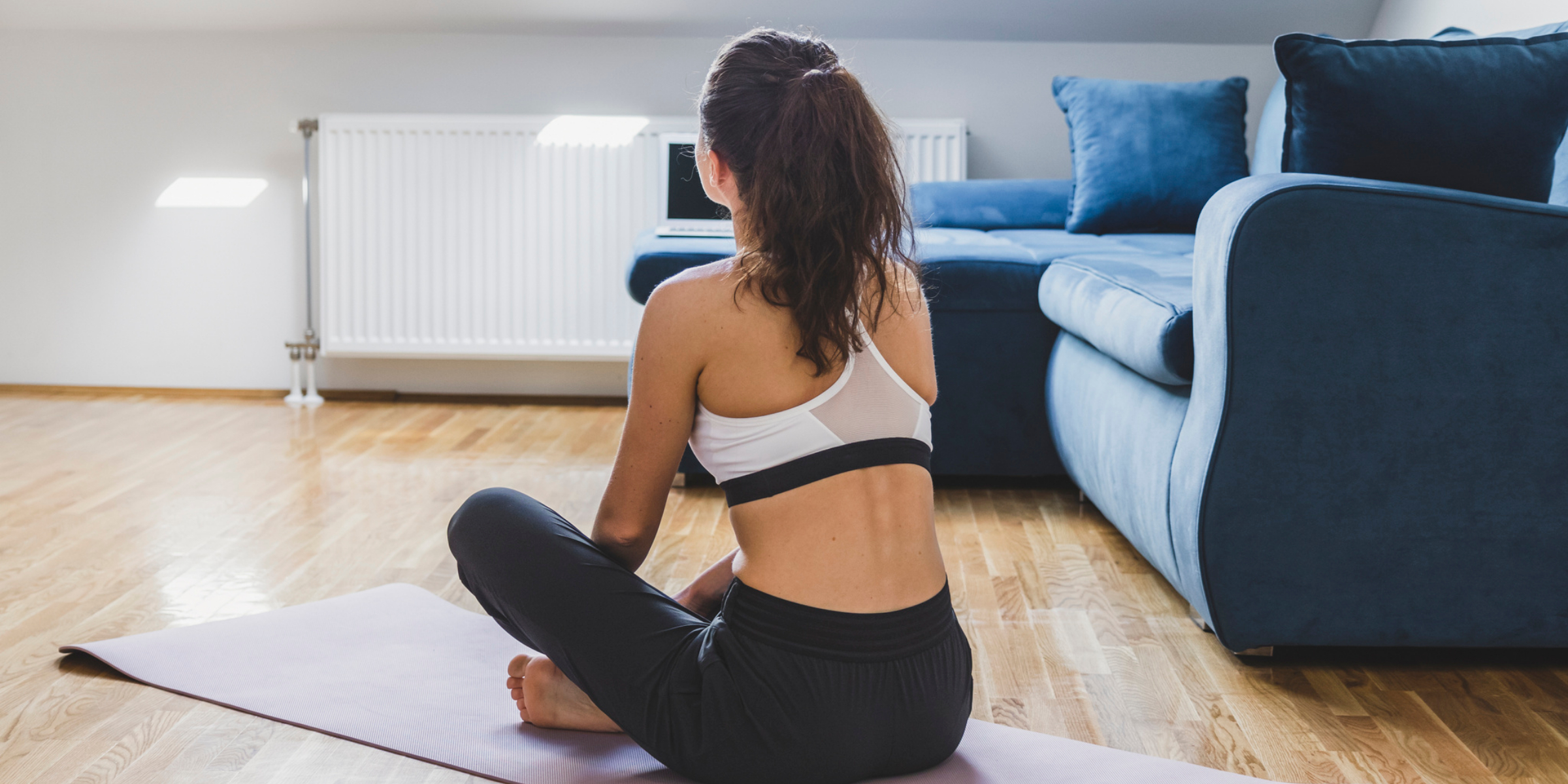If you’re tired of struggling to find time for yoga classes or feeling limited by studio schedules, you’re not alone. Did you know that 75% of yoga practitioners prefer practicing at home? Starting a consistent at-home yoga practice can give you the freedom to practice whenever and wherever you want.
To start a consistent at-home yoga practice, follow these steps:
- Set a schedule: Choose a specific time each day that works best for you and commit to practicing yoga during that time.
- Create a dedicated space: Designate a specific area in your home where you can practice yoga without distractions. Clear the space, lay down a yoga mat or a soft surface, and gather any props you may need.
- Choose a routine or class: Decide whether you want to follow a specific routine or join an online yoga class. There are many resources available online that offer guided yoga classes for all levels and durations.
- Start with short sessions: If you’re new to yoga or have a busy schedule, begin with shorter sessions, such as 10-15 minutes, and gradually increase the duration as you become more comfortable and consistent.
- Set realistic goals: Set achievable goals for your at-home yoga practice. Whether it’s practicing three times a week or completing a specific pose, having goals will keep you motivated and focused.
- Stay consistent: Make a commitment to yourself to practice yoga regularly. Even if you can only spare a few minutes each day, consistency is key in establishing a sustainable at-home yoga practice.
- Listen to your body: Pay attention to how your body feels during and after each practice. Modify poses or take breaks if needed, and always prioritize your safety and well-being.
- Stay motivated: Find inspiration to keep your practice going. This can be through reading books about yoga, following inspiring yoga accounts on social media, or joining online communities where you can connect with fellow yogis.
In this guide, we’ll take a deep dive into the steps to create your own at-home yoga sanctuary, choose the right online classes, and stay motivated on your yoga journey. Prepare yourself to embrace the freedom of practicing yoga on your own terms.
Benefits of an At-Home Yoga Practice
You will appreciate the convenience and flexibility of practicing yoga at home. Engaging in yoga in the comfort of your own space grants you the freedom to choose when and where you wish to practice.
One of the primary physical advantages of a home-based yoga routine is the increased flexibility it brings. As you consistently engage in various poses, you will notice a greater suppleness in your muscles and an improvement in your range of motion. Additionally, yoga aids in building strength, particularly in your core muscles, which can enhance your posture and overall stability.
An at-home yoga practice not only offers physical benefits but also provides numerous mental advantages. Yoga is renowned for its capacity to reduce stress and promote relaxation. By focusing on your breath and transitioning through the poses, you can quiet your mind and attain a sense of tranquility. Regular yoga practice can also enhance your concentration and foster mental clarity. It creates a space for introspection and self-care, enabling you to connect with your inner self and cultivate a heightened sense of self-awareness.
Setting Up Your At-Home Yoga Space
Creating a cozy and inviting atmosphere for your at-home yoga routine requires setting up a dedicated space with a yoga mat, props, and calming decorations.
It is crucial to establish a peaceful environment that allows you to fully immerse yourself in the present moment and connect with your body and mind.
Begin by finding a quiet corner or room in your home where you can have privacy and uninterrupted time for your practice.
Position a yoga mat on the floor to provide a soft and stable surface for your movements. If you possess any props such as blocks, straps, or bolsters, keep them nearby to support and enhance your practice. These aids can assist you in modifying poses and deepening your stretches, enabling you to explore your body’s capabilities safely and comfortably.
Incorporating mindfulness techniques into your space can further enhance your yoga practice. Consider incorporating calming decorations such as candles, incense, or plants to create a soothing atmosphere. You can even play soft, instrumental music or nature sounds to aid in relaxation and focus.
Remember, this space is yours, and you have the freedom to personalize it to your liking. Experiment with different elements and discover what works best for you.
Essential Yoga Equipment for Home Practice
When it comes to practicing yoga at home, you might be wondering whether to invest in a yoga mat or simply use a towel.
In this discussion, we will explore the advantages and disadvantages of using a mat compared to a towel, helping you make an informed decision.
Additionally, we will discuss the significance of props for support during your practice and the various accessories that can enhance the versatility of your yoga routine.
Mat Vs. Towel
If you’re pondering over whether to use a mat or a towel for your at-home yoga practice, take into consideration the advantages of each. Both options have their perks, so it ultimately depends on your personal preferences and needs. Here are some factors to think about:
- Mat Options:
- Cushioning: A high-quality yoga mat offers ample padding to support your joints and prevent discomfort during your practice.
- Stability: Mats are designed with a non-slip surface, ensuring stability and preventing any accidental slips or falls.
- Durability: Yoga mats are constructed to withstand regular use, making them a long-lasting investment.
- Towel Alternatives:
- Portability: Towels are lightweight and easy to carry, making them an excellent choice for travel or outdoor yoga sessions.
- Absorbency: Towels are highly absorbent, making them ideal for hot yoga or if you tend to sweat a lot during your practice.
- Versatility: Towels can also be utilized for other purposes such as cushioning or as props during certain yoga poses.
Consider your priorities and find the option that suits your needs best. Remember, the objective is to create a comfortable and enjoyable practice that supports your freedom of movement.
Props for Support
Incorporating props, such as blocks or straps, into your yoga routine can provide valuable support and enhance your practice.
These tools can be especially beneficial for beginners or individuals focusing on specific aspects of their practice.
For instance, using a block during standing poses can help improve balance by bringing the ground closer to you, allowing for increased stability and confidence.
Additionally, if flexibility is a challenge, a strap can be a game-changer. It enables you to extend your reach and deepen stretches while maintaining proper alignment.
It’s important to note that props are not intended to replace your own efforts, but rather to assist you in finding more freedom and ease in your practice.
Accessories for Versatility
To enhance the versatility of your routine, consider incorporating accessories like yoga wheels or bolsters into your practice. These multi-functional props can elevate your yoga experience and offer support in various poses.
Here are three alternative accessories to consider:
- Yoga Wheel: This circular prop can deepen backbends, enhance flexibility, and bolster core strength. It also aids in balance and stability during challenging poses.
- Bolster: A firm cushion, the bolster can provide support for different body parts during restorative poses. It offers gentle assistance and promotes deep relaxation in each posture.
- Yoga Strap: This long and adjustable strap can facilitate proper alignment and extend your reach in poses. It proves particularly useful for stretching tight muscles and improving flexibility.
Integrating these adaptable props into your practice will unveil new possibilities, allowing you to explore different variations and deepen your yoga journey. Embrace the freedom to experiment and discover what works best for you.
Creating a Consistent Yoga Schedule
When it comes to establishing a consistent yoga schedule, there are a few crucial factors to consider.
To begin with, it is crucial to set practical objectives. You want to challenge yourself, while ensuring that your goals align with your current way of life.
Overcoming time limitations is also of utmost importance in order to incorporate yoga into your daily routine. Discovering small pockets of time throughout the day or making adjustments to your schedule can help you prioritize your practice.
Lastly, implementing accountability strategies can truly make a difference. Whether it involves practicing with a companion, becoming part of a yoga community, or utilizing a yoga app that tracks your progress, having someone or something to keep you accountable will aid in your commitment to maintaining a consistent schedule.
Setting Realistic Goals
Start by evaluating your current fitness level and establishing attainable objectives for your at-home yoga practice. This will assist you in maintaining practical expectations and staying motivated on your yoga journey.
Here are some suggestions to assist you in setting realistic goals and effectively managing your time:
- Begin by assessing your present fitness level. Take note of your flexibility, strength, and stamina. This will enable you to measure your progress and monitor your advancements.
- Set reachable goals that align with your current fitness level. For instance, if you’re a novice, aim to engage in yoga for 10-15 minutes each day and gradually extend the duration as you become more comfortable.
- Establish a schedule that suits your needs. Find the time of day when you’re most likely to devote yourself to your practice. It could be early morning, during your lunch break, or in the evening. Stick to a consistent schedule to incorporate yoga into your daily routine.
Overcoming Time Constraints
Overcoming the constraints of limited time can be quite a challenge, but it is crucial to find a schedule that suits your needs. When it comes to establishing a consistent yoga practice at home, effective time management becomes essential. Prioritizing self-care is not a mere luxury; it is absolutely necessary for your physical and mental well-being.
To conquer time limitations and incorporate yoga into your daily routine, consider employing the following strategies.
Begin by identifying small pockets of time during your day that can be dedicated to yoga. This could involve waking up slightly earlier in the morning or taking a short break during work hours.
Next, create a flexible schedule that aligns with your lifestyle. It is important to be realistic and start with shorter yoga sessions, gradually increasing the duration as you grow more comfortable.
Finding Accountability Strategies
To make sure you stay on track with your commitment to yoga, it’s crucial to establish accountability strategies that work for you. Here are some ways to help you find accountability and stay motivated in your at-home yoga practice:
- Join a yoga community: Connecting with individuals who share your passion for yoga can provide a sense of accountability and support. Look for virtual yoga communities or forums where you can interact with fellow practitioners, share your progress, and seek guidance when needed.
- Find virtual classes: Many yoga studios and instructors offer online classes that you can join from the comfort of your own home. These classes provide structure and guidance, making it easier to stay committed. Look for online platforms or websites that offer a variety of virtual yoga classes suited to your level and preferences.
- Create a schedule: Set aside dedicated time for your yoga practice each day or week. Establishing a routine will help you stay consistent and accountable to yourself. Block off the time in your calendar and treat it as an important appointment with yourself.
Choosing the Right Online Yoga Classes
Finding the perfect online yoga classes can assist in establishing a consistent at-home practice. With numerous options available, it can be overwhelming to make a selection. But fear not, as I am here to guide you in choosing the ideal online yoga instructor who will aid you in achieving liberation through your practice.
Primarily, it is crucial to conduct thorough research. Seek out instructors who possess extensive experience and certifications in yoga. Explore their biographies, watch their videos, and determine if their teaching style resonates with you. Additionally, check if they offer a variety of classes that cater to your needs, whether you are a novice or an advanced practitioner.
Furthermore, take into account the type of yoga you desire to practice. Are you inclined towards Hatha, Vinyasa, or perhaps Kundalini? Different instructors specialize in distinct styles, so ensure that you select one that aligns with your preferences.
Lastly, contemplate the accessibility and flexibility of the classes. Do they provide live sessions or pre-recorded videos? Can you stream them at your convenience? Opt for classes that grant you the freedom to practice whenever and wherever suits you best.
Tips for Staying Motivated in Your At-Home Yoga Journey
Maintaining motivation throughout your at-home yoga journey can be quite challenging, but incorporating small daily rituals and setting attainable goals will undoubtedly help keep you engaged and inspired.
Here are some helpful tips to assist you in staying motivated and cultivating discipline:
- Establish a sacred space: Designate a specific area within your home that is solely dedicated to your yoga practice, ensuring it is free from any distractions. Personalize this space with objects that truly inspire you, such as scented candles, vibrant plants, or meaningful artifacts. This will effectively create a serene and inviting atmosphere, enhancing your overall experience.
- Develop a consistent schedule: Determine a regular time slot for your yoga sessions, whether it be during the early morning or in the evening. By establishing a set routine, you will find it much easier to maintain motivation and build discipline.
- Embrace variety: Infuse your yoga practice with diversity to keep it interesting and engaging. Explore different styles of yoga, experiment with new poses, or even incorporate various props. This will effectively prevent monotony and help you stay fully immersed in your practice.
Always remember, staying motivated and cultivating discipline is a personal journey that varies from individual to individual. Discover what works best for you and relish in the freedom that comes with practicing yoga at home.
Continuously challenge yourself, set achievable goals, and celebrate your progress along the way.
Conclusion
Starting a consistent at-home yoga practice can have numerous benefits for your physical and mental well-being.
To begin, it is important to set up a dedicated space where you can fully immerse yourself in your practice. Investing in essential equipment, such as a yoga mat and props, can further enhance your experience.
Creating a regular schedule is also crucial for maintaining a consistent practice. This will help you establish a routine and make it easier to prioritize your yoga sessions. With the wide availability of online yoga classes, you have a plethora of options to choose from that cater to your preferences and skill level.
It is worth mentioning that a recent survey found that 75% of individuals who incorporated regular at-home yoga reported feeling more calm and centered in their daily lives. This demonstrates the transformative power of yoga and highlights its importance in promoting relaxation and focus.
So, why not give it a try? Embrace the unique and incredible benefits that yoga can bring to your life. By delving into the practice in the comfort of your own home, you can experience firsthand its positive impact on your overall well-being.




